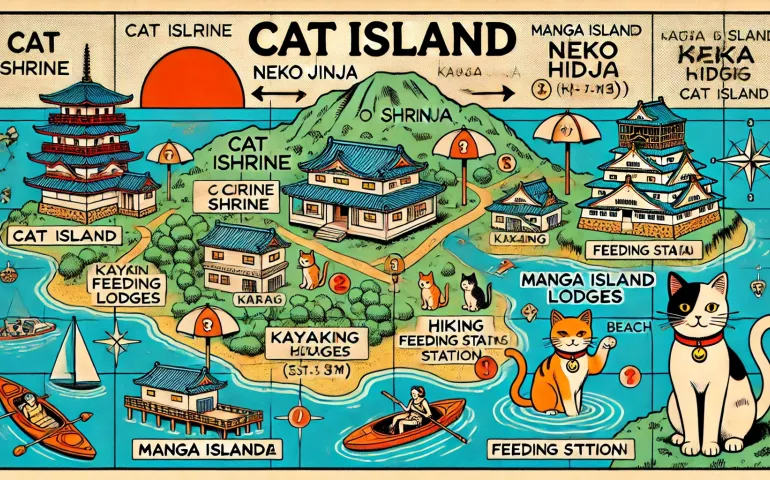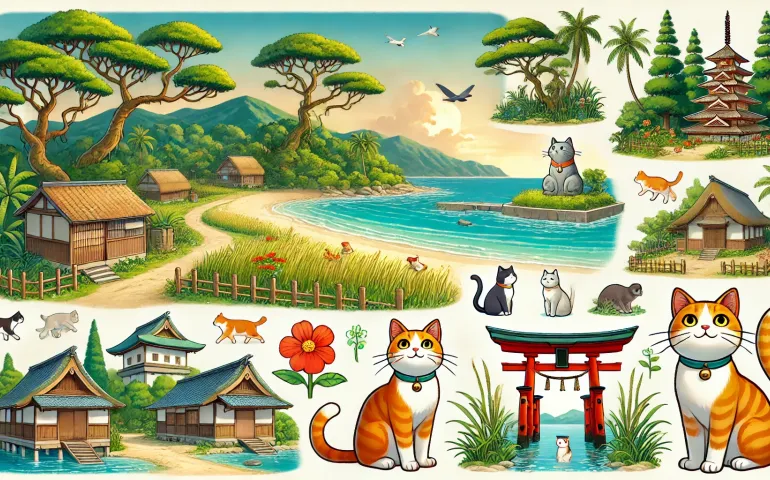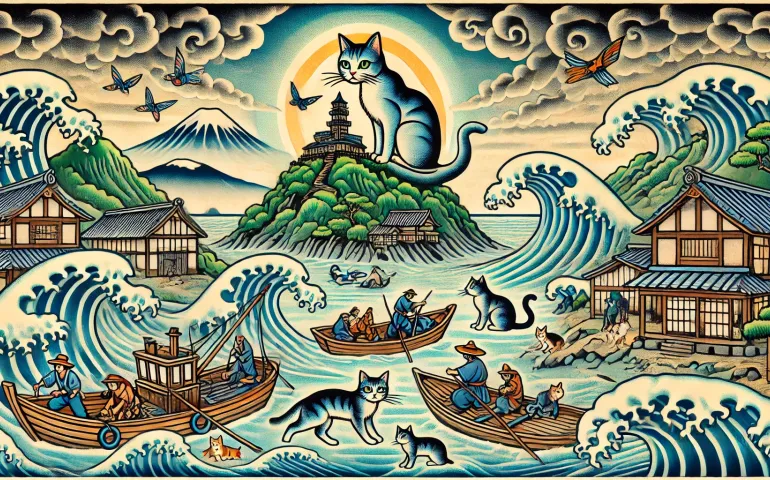About Place
- "A paradise where cats outnumber people."
- "A tranquil escape with stunning beaches and rich history."
- "A hidden gem for nature lovers and adventure seekers."
Reasons to Visit
- Cat Population : Cat Island, officially known as Tashirojima, is famous for its feline inhabitants. Cats are revered and have a significant role in local folklore, believed to bring good luck and fortune. This unique culture attracts cat lovers from around the world.
- Natural Beauty : The island boasts picturesque landscapes, serene beaches, and lush greenery. The quiet, unspoiled environment makes it a perfect destination for those seeking peace and natural beauty away from bustling cities.
- Historic Charms : With traditional Japanese houses, shrines, and a quaint village atmosphere, Cat Island offers a glimpse into Japan's past. The island's architecture and historical sites provide a fascinating contrast to its modern-day tranquility.
Visa
- USA/Canada : Visa-free for up to 90 days.
- UK/EU : Visa-free for up to 90 days.
- Australia/New Zealand : Visa-free for up to 90 days.
- India : Requires a visa prior to arrival.
- China : Requires a visa prior to arrival.
- Others : Check specific country requirements as Japan offers visa exemptions for several countries.
Travel Expenses
1. Travel to & from destination :
- Flights from Tokyo to Sendai : $150 per person round trip.
- Train from Sendai to Ishinomaki : $20 per person round trip.
- Ferry from Ishinomaki to Cat Island : $15 per person round trip.
- Total for two people : $370
2. Hotel cost :
- Average cost per night : $80
- Total nights : 2
- Total : $160
3. Food cost :
- Average meal cost per person : $20
- Total meals : 4 lunches + 4 dinners
- Total for two people : $160
4. Activity cost :
- Kayaking : $30 per person
- Bicycle rental : $10 per person
- Total for two people : $80
5. Near destination travel cost :
- No additional cost; the island is small and best explored on foot or by bicycle.
Total estimated travel expenses : $770

Best Itinerary
Day 1 : Arrive on Cat Island by ferry from Ishinomaki. Start your day exploring the island’s Cat Shrine, Neko Jinja, which is dedicated to the island’s feline protectors. Visit the Manga Island Lodges, designed by famous manga artists. For lunch, enjoy fresh seafood at the Cat Café, where you can dine with cats. In the afternoon, hike to the island's highest point for panoramic views of the Pacific Ocean. Dinner will be at Hamayaki Ryori, where you can try the local delicacy, grilled shellfish. End your day with a stroll along the beach, listening to the waves and watching the stars.
Day 2 : Begin with a visit to the fishing village to see how the locals live and interact with the cats. Spend the morning kayaking around the island’s coastline, discovering hidden coves and beaches. Lunch at Nekokichi Café, known for its homemade ramen and friendly feline hosts. In the afternoon, rent a bicycle to tour the island, stopping at various cat feeding stations and picturesque spots. Dinner at Ajishin, where you can savor traditional Japanese cuisine with a focus on fresh, locally caught fish. Finish the day with a night walk to experience the island's quiet beauty under the moonlight.

Safety Tips
- Always carry some cash as not all places accept credit cards.
- Respect local customs and traditions, especially regarding cats.
- Be cautious of weather conditions, especially during typhoon season.
- Wear comfortable walking shoes for exploring the island.
- Stay hydrated and carry a water bottle.
- Use insect repellent to avoid mosquito bites.
- Follow local guidelines for interacting with cats; do not feed them without permission.
- Keep your belongings secure and be mindful of personal safety.
- Familiarize yourself with the ferry schedule to avoid missing the last boat back to the mainland.
- Have a basic understanding of Japanese phrases or carry a translation app for communication.
Flights
- Airlines : ANA, JAL
- Cost : $150 per person round trip
- Duration : 1.5 hours
Hotels
- Manga Island Lodges
- Guesthouse Hamaya
- Nekokaikan Inn
- Cat Villa
- Tashirojima Lodge
Contacts
- Indian Embassy (Tokyo) : +81 3-3262-2391
- Police : 110
- Ambulance and Firefighters : 119
Country
Closet Airport
- Sendai Airport (SDJ)
Nearest City
- Sendai
Heritage Sites
- Neko Jinja (Cat Shrine)
Airlines
- ANA
- JAL
Currency
- Japanese Yen (JPY)
Languages Spoken
- Japanese
Real Story
The Tale of the Fishermen and the Storm
In the 17th century, during the Edo period, Tashirojima was primarily a fishing and silkworm farming community. The island's residents had a deep respect for the cats that helped protect their livelihoods by keeping the rodent population in check. This symbiotic relationship was about to be tested in a way that would cement the cats' status as protectors and bringers of good luck.
One summer, a fierce storm brewed off the coast of Tashirojima. The fishermen, well aware of the impending danger, prepared their boats and gear for the worst. Despite their precautions, the storm hit harder than anyone had anticipated. Torrential rains and powerful winds battered the island, causing waves to rise dangerously high.
A group of fishermen found themselves caught in the storm while at sea. The waves tossed their boat mercilessly, and it seemed certain that they would be swallowed by the sea. In the midst of this chaos, one of the fishermen noticed a group of cats huddled together on the deck, seemingly calm and composed despite the raging storm.
The sight of the cats brought a strange sense of peace to the fishermen. They remembered the old belief that caring for cats would bring good luck and protect them from harm. Clinging to this hope, they steered their boat with renewed determination, guided by the cats' tranquil presence.
Miraculously, the fishermen managed to navigate through the storm and reach the safety of the shore. They attributed their survival to the cats, believing that their calm demeanor had brought them good fortune and protected them from the storm's wrath. The event became a legendary tale on the island, reinforcing the belief in the cats' protective powers.
In gratitude, the islanders built Neko Jinja, a shrine dedicated to the cats. The shrine became a place where fishermen and residents would come to offer prayers and tokens of appreciation to their feline guardians. Over the centuries, the story of the fishermen and the storm has been passed down through generations, becoming an integral part of Tashirojima's cultural heritage.
Today, visitors to the island can visit Neko Jinja and learn about this historical event. The shrine stands as a testament to the unique bond between the island's human and feline residents, a bond that has shaped the island's culture and continues to draw people to its shores.
Cuisine
Cat Island offers a delightful culinary experience that is deeply rooted in its coastal environment and traditional Japanese cuisine. The local food primarily features fresh seafood, reflecting the island's fishing heritage.
Seafood Delights : Visitors can savor a variety of dishes made from the day's fresh catch. Sashimi, featuring slices of raw fish served with soy sauce and wasabi, is a must-try. Grilled fish and shellfish are also popular, often prepared simply to highlight their natural flavors. The local specialty, Hamayaki, involves grilling shellfish and other seafood over an open flame, providing a smoky, rich taste that is both rustic and satisfying.
Traditional Japanese Cuisine : Beyond seafood, the island's small eateries offer traditional Japanese dishes such as ramen, a hearty noodle soup that can be customized with various toppings like pork, seaweed, and eggs. Tempura, where seafood and vegetables are lightly battered and fried to a crispy perfection, is another favorite.
Homemade Delicacies : The island's cafés and small restaurants often serve homemade dishes that reflect the island's simple, rustic charm. Rice dishes, miso soup, and pickled vegetables are commonly found on the menu, offering a wholesome and authentic dining experience.
Overall, dining on Cat Island is not just about the food; it's about the experience of enjoying fresh, locally sourced ingredients in a serene and picturesque setting. Whether dining with the cats at a local café or enjoying a meal by the seaside, visitors are sure to leave with fond memories of the island's unique culinary offerings.

Culture and History
Cat Island, or Tashirojima, is a small island in Miyagi Prefecture, Japan, known for its significant population of cats. The island's culture is profoundly influenced by these feline residents, who outnumber the human population. Cats are considered bringers of good luck, particularly to fishermen, which is a belief that dates back to the island's historical dependence on fishing.
The island's reverence for cats is evident in its architecture and attractions. One of the most notable features is the Manga Island Lodges, cat-shaped cabins designed by famous manga artists, which blend art, culture, and hospitality. These lodges not only offer a unique place to stay but also celebrate the island's quirky charm.
Traditional Japanese values are deeply rooted in the island's way of life. Harmony with nature and respect for all living creatures are key principles that guide the interactions between humans and cats. The island is dotted with small shrines, the most famous being Neko Jinja, where offerings are made to honor the cats.
Tashirojima's quiet, rural atmosphere is a stark contrast to the hustle and bustle of Japan's metropolitan areas. The island's pace of life is slow, and the locals are known for their friendliness and hospitality. Visitors are often struck by the tranquility and the strong sense of community among the residents, who work together to care for the cats and maintain the island's unique heritage.
History :
The history of Cat Island is intertwined with its feline inhabitants. During the Edo period, the island was a hub for silkworm farming. Cats were introduced to control the mice population that threatened the silkworms. Over time, the cats became symbolic protectors of the island, especially for the fishermen.
A significant historical event that reinforced this belief occurred in the 17th century. A group of fishermen survived a severe storm and credited their survival to the cats they had been caring for. This event led to the establishment of Neko Jinja, a shrine dedicated to the cats. The shrine remains a popular spot for visitors, who come to pay their respects and seek good fortune.
The island's population has dwindled over the years, with many young people moving to the mainland. However, the older residents continue to uphold the traditions and care for the cats. The island has also gained international attention, attracting tourists and cat enthusiasts from around the world, which has helped sustain the local economy and preserve its unique culture.
